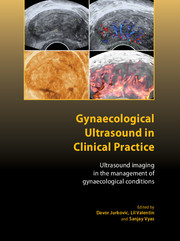 Gynaecological Ultrasound in Clinical Practice
Gynaecological Ultrasound in Clinical Practice Book contents
- Frontmatter
- Contents
- About the authors
- Abbreviations
- Preface
- 1 Ultrasound imaging in gynaecological practice
- 2 Normal pelvic anatomy
- 3 The uterus
- 4 Postmenopausal bleeding: presentation and investigation
- 5 HRT, contraceptives and other drugs affecting the endometrium
- 6 Diagnosis and management of adnexal masses
- 7 Ultrasound assessment of women with pelvic pain
- 8 Ultrasound of non-gynaecological pelvic lesions
- 9 Ultrasound imaging in reproductive medicine
- 10 Ultrasound imaging of the lower urinary tract and uterovaginal prolapse
- 11 Ultrasound and diagnosis of obstetric anal sphincter injuries
- 12 Organisation of the early pregnancy unit
- 13 Sonoembryology: ultrasound examination of early pregnancy
- 14 Diagnosis and management of miscarriage
- 15 Tubal ectopic pregnancy
- 16 Non-tubal ectopic pregnancies
- 17 Ovarian cysts in pregnancy
- Index
1 - Ultrasound imaging in gynaecological practice
Published online by Cambridge University Press: 05 February 2014
- Frontmatter
- Contents
- About the authors
- Abbreviations
- Preface
- 1 Ultrasound imaging in gynaecological practice
- 2 Normal pelvic anatomy
- 3 The uterus
- 4 Postmenopausal bleeding: presentation and investigation
- 5 HRT, contraceptives and other drugs affecting the endometrium
- 6 Diagnosis and management of adnexal masses
- 7 Ultrasound assessment of women with pelvic pain
- 8 Ultrasound of non-gynaecological pelvic lesions
- 9 Ultrasound imaging in reproductive medicine
- 10 Ultrasound imaging of the lower urinary tract and uterovaginal prolapse
- 11 Ultrasound and diagnosis of obstetric anal sphincter injuries
- 12 Organisation of the early pregnancy unit
- 13 Sonoembryology: ultrasound examination of early pregnancy
- 14 Diagnosis and management of miscarriage
- 15 Tubal ectopic pregnancy
- 16 Non-tubal ectopic pregnancies
- 17 Ovarian cysts in pregnancy
- Index
Summary
Introduction
Diagnostic medical ultrasound was first developed in the 1960s but it did not become part of routine clinical practice until the late 1970s. Transvaginal ultrasound scanning was introduced in the 1980s and it has expanded rapidly because of the improved quality of pelvic imaging provided by high frequency (5–7 Hz) transducers. Although the transvaginal view of the pelvis is more limited in comparison with transabdominal scans, in most cases it is sufficient for a thorough evaluation of the uterus and adnexa. This advantage is particularly apparent in women who are overweight and in those with a retroverted uterus.
It is important that, before commencing a scan, a complete medical history is taken. Ultrasound examination should complement rather than replace clinical assessment, which ensures the appropriate interpretation of the scan findings. Use of gynaecological scan without an appropriate history or indication will almost certainly yield a multiplicity of abnormal scan findings, which may be clinically irrelevant and which may result in inappropriate management. Ultrasound examination follows the principles of clinical palpation. This combined examination is often helpful when trying to identify the source of pelvic pain or assessing mobility and tenderness of a pelvic mass. It can also be valuable in establishing the presence or absence of a lesion. This is particularly important in patients who are difficult to examine clinically (because of obesity, lack of relaxation or involuntary guarding) or where there is a conflict between the findings at clinical pelvic examination and the patient's symptoms.
Keywords
- Type
- Chapter
- Information
- Gynaecological Ultrasound in Clinical PracticeUltrasound Imaging in the Management of Gynaecological Conditions, pp. 1 - 6Publisher: Cambridge University PressPrint publication year: 2009
